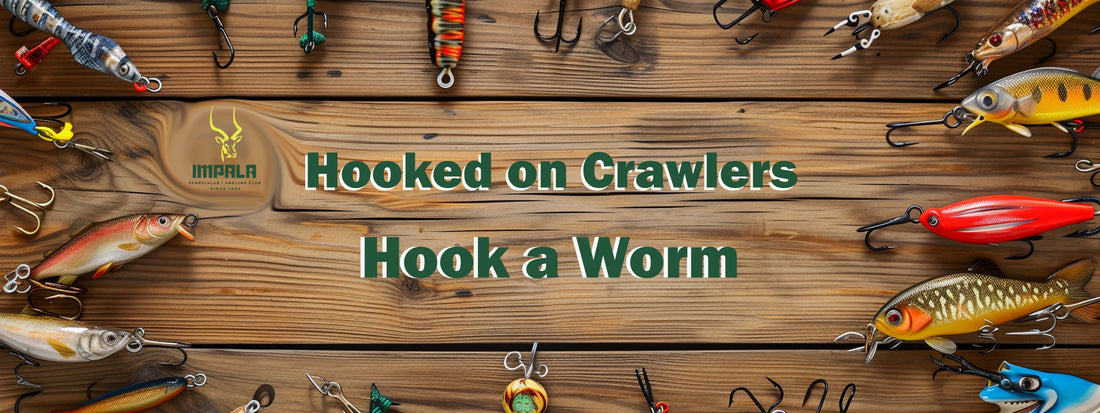At Impala Angling Club, we’re excited to bring you another instalment in our Hooked on Crawlers series. In this article, we’re diving into the art of hooking worms, one of the most versatile and effective baits in angling. Whether you’re targeting carp, barbel, or any other species, mastering worm-hooking techniques can make all the difference in your catch rate.
In this guide, we’ll outline step-by-step methods shared by one of our skilled anglers, so you can confidently prepare your bait and maximise your success.
Worm Hooking 101
Using worms as bait requires careful handling and technique to ensure the bait stays on the hook while also enticing fish with its natural movement. There are two main approaches to hooking worms effectively: creating a worm bundle and threading a worm.
Creating a Worm Bundle
A worm bundle is an excellent way to create an enticing, wiggling presentation for fish. Follow these steps:- Prepare Your Tools: Use a worm needle for this technique. This allows you to load worms efficiently without damaging them.
- Threading Worms:
- Start by piercing the worm just behind its salt gland (a slightly thicker part of the worm’s body).
- Slide the worm onto the needle, ensuring you leave about a third of the worm free to wiggle.
- Repeat the process with one or two additional worms to create a cluster. Sometimes up to 5 at a time.
- Attach to the Hook: Hook the worm needle onto the actual hook, then slide the worms onto it. Position the cluster around the hook curve to form a wiggling, natural-looking bait.
- Add a Floatie (Optional): Slide a floatie (e.g., a garlic-flavoured float) onto the hook tip. The floatie will obscure the hook while adding buoyancy and attraction.
Threading a Worm
Threading a worm creates a sleek, streamlined presentation, ideal for species like carp that prefer a subtle approach.- Start with the Hook: Insert the hook into the worm’s head and thread the worm’s body along the hook shank.
- Cover the Hook Curve: Slide the worm up the hook until its body covers the curve, ensuring the worm remains secure.
- Add a Floatie: Place a small floatie on the sharp end of the hook, leaving just a bit of the hook point exposed. This combination balances natural movement with increased visibility and buoyancy.
Advanced Techniques
The "First Cast" Rig
Our angler recommends using a weighted noose (around 80 cm in length) for your first cast of the morning. This rig is particularly effective for targeting larger fish.- Hook Setup: Use a larger hook, ideal for holding heavier bait like dough balls, floaties, or worm bundles.
- Bait Combination: Attach a floatie to the hook, followed by a dough ball, a single worm, or a combination of worms and floaties.
- Casting Distance: This rig is designed for long-distance casting, making it perfect for reaching areas where bigger fish tend to feed.
Creating a Worm Cluster
For added movement and attraction, impale up to five worms on a single hook. Here’s how:- Pierce and Position: Start with the worm’s head and pierce through the body, leaving enough of the worm free to move naturally.
- Cluster Placement: Push the worms down to the curve of the hook, creating a lively, wiggling cluster that mimics natural prey.
- Hook Choice: Ensure you use a hook with an eye that allows you to slide the worms from the needle onto the hook easily.
Tips for Success
- Flavours Matter: Experiment with flavoured floats (e.g., cinnamon or garlic) to attract fish more effectively. Add dough at the back of the float.
- Use Movement to Your Advantage: Ensure some part of the worm remains free to wiggle. It’s this natural movement that catches a fish’s attention.
- Check Hook Size: Match your hook size to the fish you’re targeting and the bait you’re using. Larger hooks are better for big fish and heavier baits.
By practicing these techniques and experimenting with different setups, you’ll soon master the art of hooking worms and increase your chances of landing a great catch.
Impala Angling Club has been at the forefront of angling since the 1960’s. This family-orientated club is passionate about growing the sport of angling while uplifting the local youth by giving them opportunities to participate in the sport. Impala Angling Club consists of various current and former provincial and national anglers within the club. The club offers a gateway to representing your province or the country.

